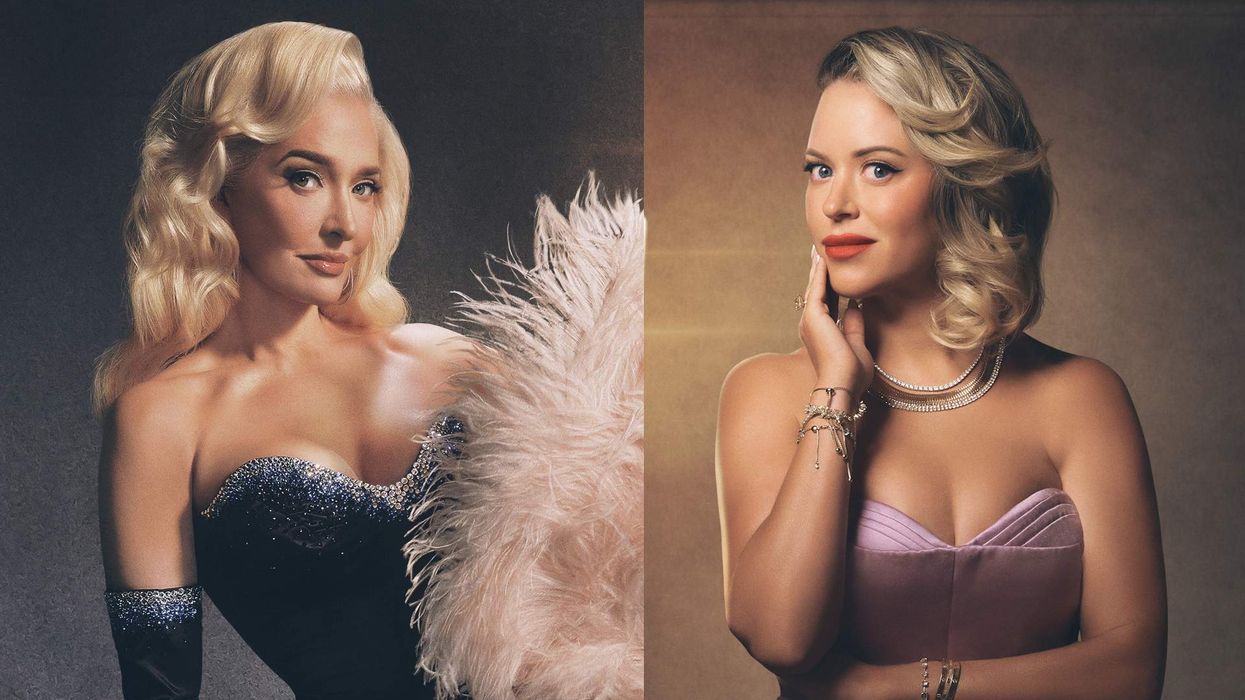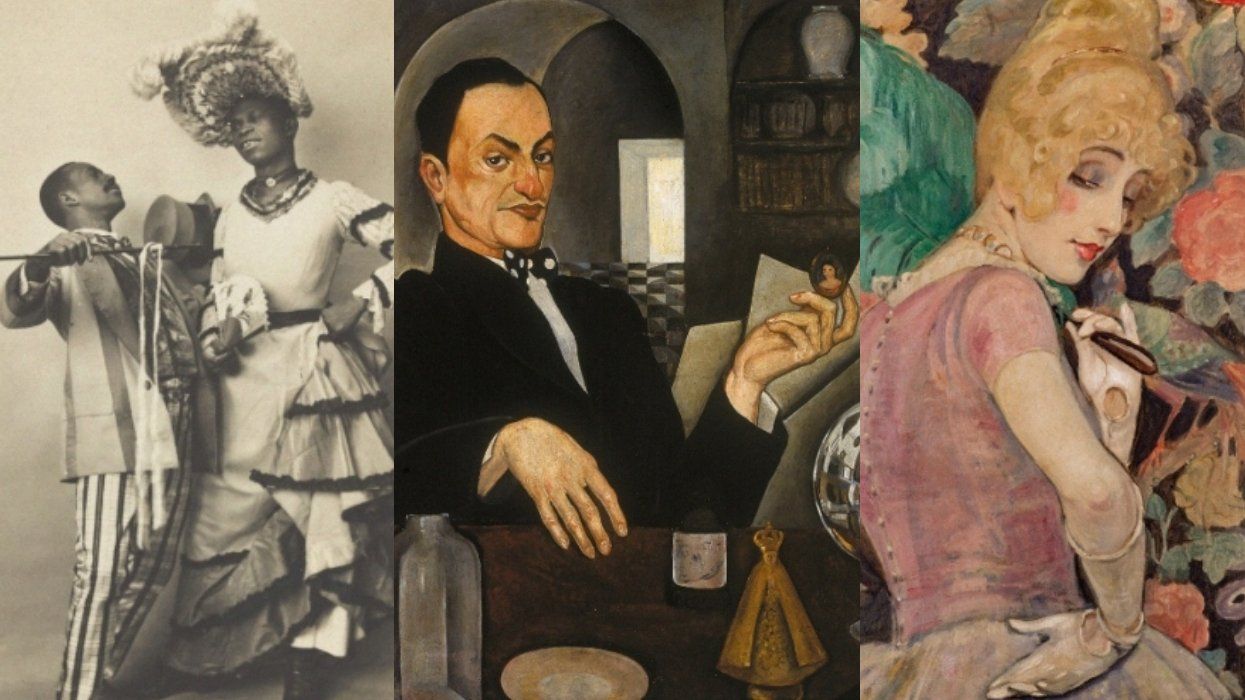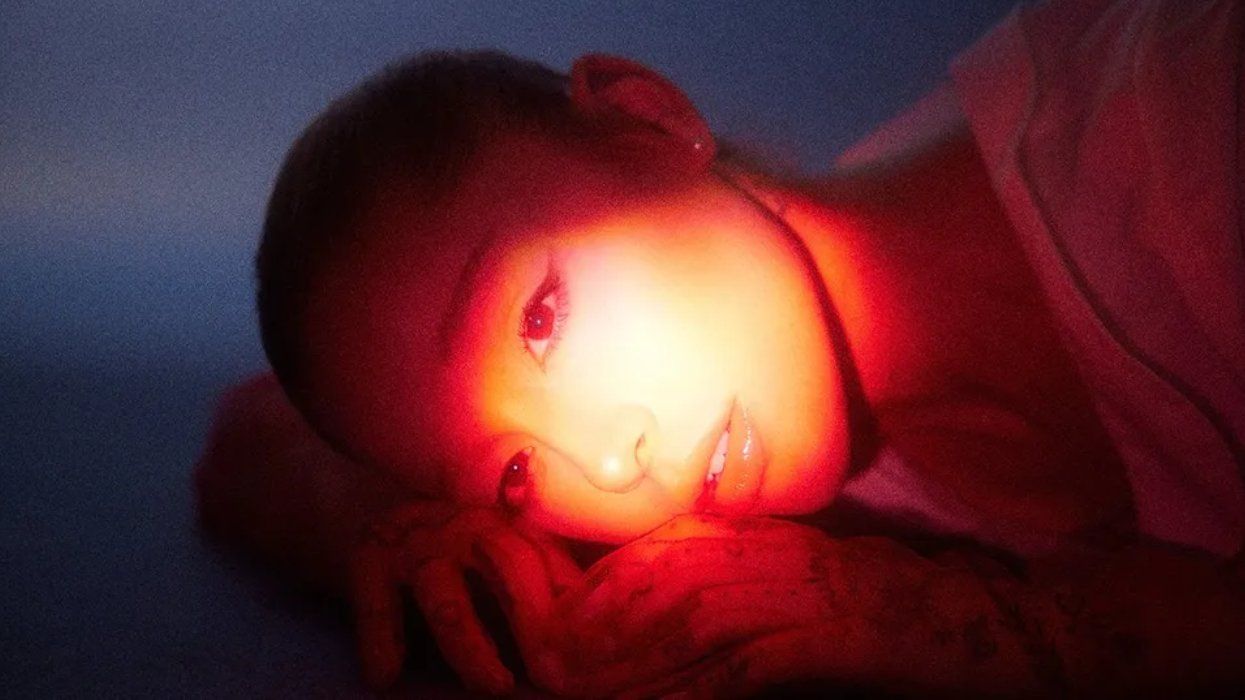The package containing my new tiara arrives on my doorstep in late June. The logo on the box is a simple black typewriter serif set near the bottom edge against a white background. It spells out the eponym: Simone Rocha. The font's playful minimalism betrays the garish glamour of the accessory itself.
Encrusted with crystal persimmon beads tethered to silver-tone hardware and topped with transparent daisy-esque blooms, my headband is on the simpler side of Rocha's offerings. Beaded embellishments are a brand staple, featured prominently in her Fall 2019 collection as earrings and barrettes, as well as detailing on sandals, purses, collars, and bustiers. Daughter to Hong Kong-born designer John Rocha, the 33-year-old Chinese-Irish Central Saint Martins-graduate debuted at London Fashion Week in September 2010 and was quickly dubbed "Queen of the New Weird" by New York magazine. Nabbing the British Fashion Award for emerging talent in 2013, followed by the British Womenswear Designer Award at the Fashion Awards in 2016, Rocha has since garnered a significant wholesale presence; opening standalone boutiques in London, New York, and Hong Kong, and establishing a cult following for an instantly recognizable aesthetic built on offbeat dichotomies. Rebellious and romantic, feminine and funereal -- Rocha might be the TikTok e-girl to Yeezy's Facetuned hypebeast.
Generally, I wear the headband around the house: while following along to YouTube makeup tutorials or vacuuming. Mostly, however, and perhaps to the tiara's dismay, it lives in the top drawer of a credenza. A tiara should nosh on mint-fed snails at Eleven Madison Park, mingle over white wine at a Chelsea art gallery, or turn its hand slowly and smirk from a sky-high balcony to a crowd of adoring onlookers -- but, more often, mine brunches with forgotten pennies and anxiously chewed pens at the bottom of a giant black tote. Symbols of power and luxury are much like the trappings of gender: Their values are only what we ascribe them.
The first time I wear it out is to a rooftop afterparty during New York Fashion Week, with matching beaded Simone Rocha earrings shaped like weeping bows, an asymmetrical tulle skirt, a backless Rick Owens cotton tee, and bright pink blush thickly applied as eyeshadow. Anxiety bubbles in my belly as I approach the hotel venue, alone, expecting policing eyes to survey my body, toe-to-tiara. I avoid glances from editors and photographers, many of whom I recognize but hesitate to approach, as I enter. But on me, the headband is a stop sign: I am approached at the door.
I run into an acquaintance who recognizes the piece at first glance. Love the jewels. I feel excited, at first, to be seen, and I bow my head to better give word to its scrumptious features: the delicate flowers, the layers of beads, the price. This interaction repeats itself throughout the evening. I humbly swear to all I meet that I purchased the headband at a steep discount (I did), then invoke its maker by name. Oh, this? It's Sih-moan. My anxieties dissolve as these brutalist accessorizing choices deflect probing questions. I feel powerful yet vulnerable, less frightened than frightening -- a lady, of sorts, in red. Is it still cross-dressing if it's Simone Rocha? I wonder.
Rocha once described the particular hue of this tiara as "sick-y" red: of rosy cheeks, Dorothy's slippers, birth, and violence. One midi, from her Fall 2019 presentation featured similarly red beading ornamenting the underside of the model's breasts, creating lines evocative of a fresh double mastectomy. The presentation had Vogue's Sarah Mower considering "the ambiguous tension between being an object of desire" and "wanting to own and direct it," a notion complicated by the fact that the collection was inspired by the 1960 slasher Peeping Tom, about a cameraman serial killer who films his victims as he murders them.
In Girls, Guts, and Giallo, a podcast launched this year that employs a queer lens to dissect the feminine image in cinema, host Annie Rose Malamet, an educator and self-described "lesbian vampire," identifies this shade as a motif in the 1964 Italian horror-thriller Blood and Black Lace. A classic of the giallo subgenre thrust into cultural consciousness with the Tilda Swintonified blockbuster remake of Suspiria, Blood and Black Lace is set in a Roman fashion salon overseen by a demure Countess Christina Como (Eva Bartok). The house is quickly revealed to be a den of greed and drugs when a masked killer targets scantily clad models on the hunt for a scandal-revealing diary. Crimson mannequins look on as the killer strangles and stabs, actions underscored with a sadistic eroticism which point to the ephemerality of beauty and youth. Countess Como, who is later revealed in a plot twist to be (spoiler) one of two killers, would, without a doubt, don this exact headband.
Washed in Rocha's "sick-y" red, the tiara reminds me that it is bound to its potential to be tragic. Coincidentally, the headband is having a street style renaissance: from Dior's subdued forms to Prada's padded poofs. Rocha's own look particularly bold atop the heads of Adwoa Aboah, Paloma Faith, and Chloe Sevigny.
In the time since I've made the relatively short jump from fashion gay to fashion they, media has decried the fall of gendered dressing. In a 2018 headline, British Vogue ponders: "Is The Fashion Industry Really Committed To The Eradication Of Gender-Specific Dressing?" Thom Browne and Vivienne Westwood have put men in skirts; Galliano's Maison Margiela combined its showrooms to make its Spring/Summer 2019 collection unisex; and a plethora of emerging New York designers -- Vasilis Loizides, Puppets and Puppets -- seem to have forgotten a binary model ever functioned as a viable selling tool.
If the eradication of fashion's gender binary is something to which we should aspire, it will not start with Simone Rocha, who creates such extremely flouncy ready-to-wear -- feather-haloed platform slippers, round-collared silk blouses, bulky tulle imaginings of Victorian gowns -- that it occasionally broaches high camp. Rather, spaces like Rocha's Wooster Street showroom, with its low-lit white walls and perspex fixtures, allow for a different kind of exploration than those that purposefully engage with the aesthetics of "androgyny." All too often, femininity feels frivolous or is looked down upon within the queer community, but the exploration that is necessary for the continued evolution of my own gender will happen with garments that feel overtly feminine. A disruption of gender norms through the detangling of the associations of dresses for women, suits for men, is something that can happen in such a space. It is okay for both to exist simultaneously.
For me, then, my new headband--a tiara--is a symbol: of power, yes, but a flippant variety. Never a crown, never absolute, one who wears a tiara bears soft power. When I wear mine, I am poignantly reminded of how we as queer people inhabit the world: Visibility is a double-edged sword. I feel beautiful yet vulnerable, with little regard for what is deemed socially acceptable, responsible, or even safe. I am a glittering stop sign, and I am not protected from violence.
This article appears in Out's 2019 Fashion Issue covered by Janet Mock and Dan Levy. The issue will be available on newsstands on October 1. To get an advanced look at the issue, preview other articles here, or view it on Apple News+, Kindle, Nook, and Zinio beginning September 24. Grab your copy by subscribing now.






























How a Crystal Tiara Helped Me Understand My Gender
Coco Romack on the tragedy and triumph of Simone Rocha’s ‘Crystal Beaded Tiara’.